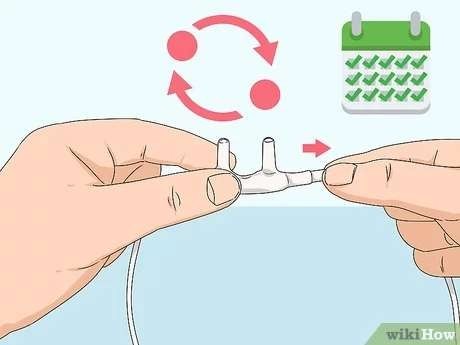A nurse is caring for a client who is receiving oxygen via nasal cannula at 4 L/min. Which of the following actions should the nurse take?
Avoid the use of humidifiers.
Position the cannula prongs curving upward in the nose.
Clean the cannula prongs daily.
Keep the oxygen tubing off the floor.
The Correct Answer is C
Clean the cannula prongs daily.

This is because the nasal cannula can become contaminated with bacteria and mucus, which can cause infection and irritation of the nasal mucosa. Cleaning the cannula prongs daily with soap and water can prevent these complications.
Choice A is wrong because humidifiers can help moisten the dry oxygen and prevent nasal dryness and bleeding. Humidifiers should be used for oxygen flow rates higher than 4 L/min.
Choice B is wrong because the cannula prongs should be positioned curving downward in the nose, not upward. This allows for better alignment with the natural direction of airflow and reduces the risk of dislodgement.
Choice D is wrong because keeping the oxygen tubing off the floor is not a specific action for nasal cannula use. It is a general safety measure to prevent tripping and contamination of the tubing.
Nursing Test Bank
Naxlex Comprehensive Predictor Exams
Related Questions
Correct Answer is A
Explanation
“I will turn all pot handles toward the back of the stove.” This indicates that the guardian understands how to prevent the toddler from pulling a pot off the stove and getting burned.
Choice B is wrong because a child’s car seat should be rear-facing until the child is at least 2 years old or reaches the maximum height and weight for the seat.
Choice C is wrong because the temperature of the water heater should be set to no higher than 120 degrees to prevent scalding injuries.
Choice D is wrong because drop-side cribs are banned in the United States due to the risk of entrapment and suffocation.
Correct Answer is A
Explanation
Encourage the client to help care for their surgical incision. This can help the client accept the body image change and promote healing.
Choice B is wrong because suggesting that the client decide about reconstruction as soon as possible can pressure the client and interfere with their coping process.
Choice C is wrong because postponing referrals to support services until the client requests them can delay the client’s emotional recovery and increase their isolation.
Choice D is wrong because avoiding talking to the client about the surgery can indicate that the nurse is uncomfortable with the topic and discourage the client from expressing their feelings.
Whether you are a student looking to ace your exams or a practicing nurse seeking to enhance your expertise , our nursing education contents will empower you with the confidence and competence to make a difference in the lives of patients and become a respected leader in the healthcare field.
Visit Naxlex, invest in your future and unlock endless possibilities with our unparalleled nursing education contents today
Report Wrong Answer on the Current Question
Do you disagree with the answer? If yes, what is your expected answer? Explain.
Kindly be descriptive with the issue you are facing.
